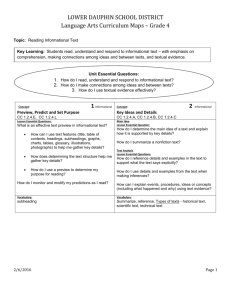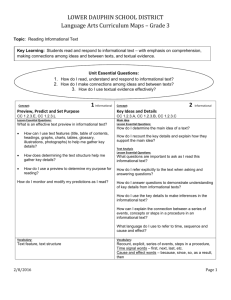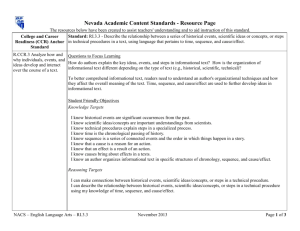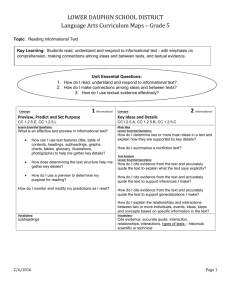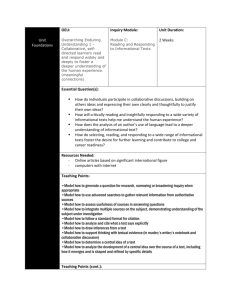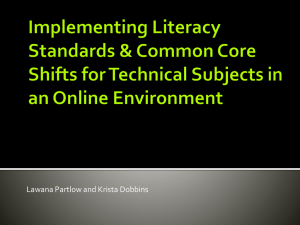Language Arts Curriculum - Lower Dauphin School District
advertisement
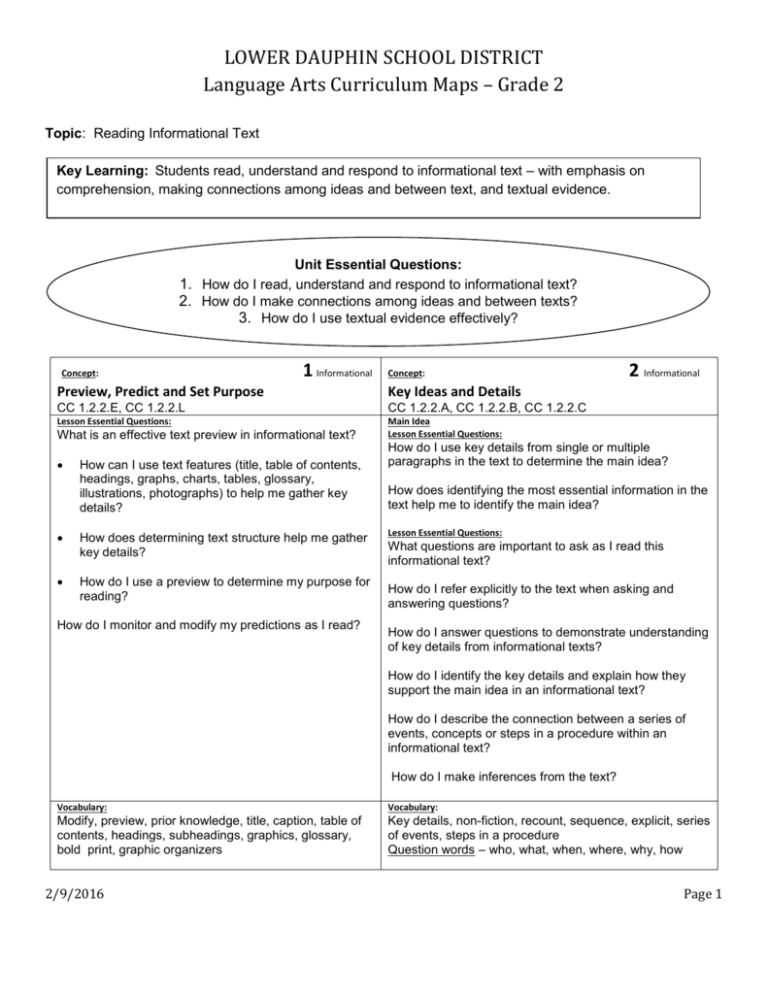
LOWER DAUPHIN SCHOOL DISTRICT Language Arts Curriculum Maps – Grade 2 Topic: Reading Informational Text Key Learning: Students read, understand and respond to informational text – with emphasis on comprehension, making connections among ideas and between text, and textual evidence. Unit Essential Questions: 1. How do I read, understand and respond to informational text? 2. How do I make connections among ideas and between texts? 3. How do I use textual evidence effectively? Concept: 1 Informational Concept: 2 Informational Preview, Predict and Set Purpose Key Ideas and Details CC 1.2.2.E, CC 1.2.2.L CC 1.2.2.A, CC 1.2.2.B, CC 1.2.2.C Lesson Essential Questions: What is an effective text preview in informational text? Main Idea Lesson Essential Questions: How do I use key details from single or multiple paragraphs in the text to determine the main idea? How can I use text features (title, table of contents, headings, graphs, charts, tables, glossary, illustrations, photographs) to help me gather key details? How does determining text structure help me gather key details? How do I use a preview to determine my purpose for reading? How do I monitor and modify my predictions as I read? How does identifying the most essential information in the text help me to identify the main idea? Lesson Essential Questions: What questions are important to ask as I read this informational text? How do I refer explicitly to the text when asking and answering questions? How do I answer questions to demonstrate understanding of key details from informational texts? How do I identify the key details and explain how they support the main idea in an informational text? How do I describe the connection between a series of events, concepts or steps in a procedure within an informational text? How do I make inferences from the text? Vocabulary: Vocabulary: Modify, preview, prior knowledge, title, caption, table of contents, headings, subheadings, graphics, glossary, bold print, graphic organizers Key details, non-fiction, recount, sequence, explicit, series of events, steps in a procedure Question words – who, what, when, where, why, how 2/9/2016 Page 1 LOWER DAUPHIN SCHOOL DISTRICT Language Arts Curriculum Maps – Grade 2 Concept: 3 Informational Concept: 4 Informational CC 1.2.2.D, CC 1.2.2.E, CC 1.2.2.F Integration of Knowledge and Ideas CC 1.2.2.G, CC 1.2.2.H, CC 1.2.2.I Point of View Lesson Essential Question: Diverse Media Lesson Essential Question: How do I determine the author’s purpose and justify my choice? How do the text features (graphic features) of the text support the understanding of key details? Text Structure Lesson Essential Questions: Evaluating Arguments Lesson Essential Question: How do readers identify and interpret statements of facts and opinions in informational texts? How do I identify and describe the reasons the author gives to support specific points in the text? How do I use various text features and search tools (e.g., captions, bold print, subheadings, glossaries, indexes, electronic menus, icons) to locate key facts or information in a text efficiently? Analysis Across Texts Lesson Essential Question: Craft and Structure How do I compare and contrast the most important points presented by two texts on the same topic? Vocabulary Lesson Essential Questions: How do I determine and clarify the meaning of unknown and multiple meaning words and phrases as they are used in grade level text? How do I use the context as a clue to understand the meaning of a word or a phrase? Vocabulary: Vocabulary: Author’s purpose, justify, text features, subheadings, glossary, index, electronic menus, icons, context Compare, contrast, cause/effect, first/second/third in sequence, text/graphic features Concept: 5 Informational Vocabulary Acquisition and Use CC 1.2.2.J, CC 1.2.2.K Lesson Essential Questions: How do I acquire new vocabulary (grade appropriate academic, conversational and general academic, domain specific)? How do I accurately use new vocabulary (grade appropriate academic, conversational and general academic)? What tools and strategies can I use to find the meaning of a word I do not know? Vocabulary: domain-specific vocabulary, academic vocabulary, conversation vocabulary 2/9/2016 Page 2 LOWER DAUPHIN SCHOOL DISTRICT Language Arts Curriculum Maps – Grade 2 Topic: Reading Literature Key Learning: Students read, understand, and respond to literature – with emphasis on comprehension, making connections among ideas and between texts, and textual evidence. Unit Essential Questions: 1. How do I read, understand and respond to literature? 2. How do I make connections among ideas and between texts? 3. How do I use textual evidence effectively? Concept: 1 Literature Concept: 2 Literature Preview, Predict and Set Purpose Key Ideas and Details CC 1.2.2.D, CC 1.2.2.K CC 1.3.2.A, CC 1.3.2.B, CC 1.3.2.C Lesson Essential Questions: What is an effective text preview in literature? Theme Lesson Essential Questions: How do I identify key details that support the central message? How can I use text features (title, author, illustrator, cover, illustrations/photographs, captions, table of contents, chapter titles) to make predictions about literary elements? How does identifying the genre of the story help me understand what I read? How do I use a preview to determine my purpose for reading? How do I monitor and modify my predictions as I read? How can I determine the central message, lesson or moral of a story? How can I give a proficient retelling of a fictional text that includes key details and the central message? Text Analysis Lesson Essential Questions: How does asking and answering questions as I read help me understand the key details in a text? How do I refer explicitly to the text when answering questions? How do I make inferences from the text? Literary Elements Lesson Essential Questions: How do a character’s words and actions contribute to the major events in a story? How do a character’s words and actions contribute to the problems (challenges) in a story? Vocabulary: Vocabulary: Modify, preview, title, author, illustrator, cover, illustrations/photographs, captions, table of contents, chapter titles, prediction, purpose Key details, lesson, central message, moral, explicit, traits, sequence, challenges, problem, solution, character, actions, contribute Question words: who, what, when, where, why and how 2/9/2016 Page 3 LOWER DAUPHIN SCHOOL DISTRICT Language Arts Curriculum Maps – Grade 2 Concept: 3 Literature Concept: 4 Literature Craft and Structure Integration of Knowledge and Ideas CC 1.3.2.D, CC 1.3.2.E, CC 1.3.2.F CC 1.3.2.G, 1.3.2.H Point of View: Lesson Essential Questions: Sources of Information Lesson Essential Question: How do I determine who is speaking when I am reading a text? How can I use information from illustrations to show I understand the characters, setting or plot? How do I read a text with different voices that to show a change in a character’s words? Text Analysis Lesson Essential Question: How do I recognize differences in points of view of the characters when reading? How can I compare and contrast two or more versions of the same story? Text Structure: Lesson Essential Question: How do I describe the structure of the story including how the beginning introduces the story and the ending concludes the story? Vocabulary: Lesson Essential Questions: How does the author’s word choice support the central message? How do special words and phrases supply rhythm to a story, poem or song? How can special words and phrases supply meaning to a story, poem or song? Vocabulary: Vocabulary: Rhythm, structure, conclude Illustrations, version Concept: 5 Literature Vocabulary Acquisition and Use CC 1.3.2.I, CC 1.3.2.J Lesson Essential Questions: How do I build new vocabulary including content-specific words and phrases? How do I use new vocabulary in daily conversation and writing? How do I use context clues to understand the meaning of a word or phrase? What tools and strategies can I use to determine the meaning of a word I don’t know? Vocabulary: Content-specific, context clues, strategies, conversation 2/9/2016 Page 4

